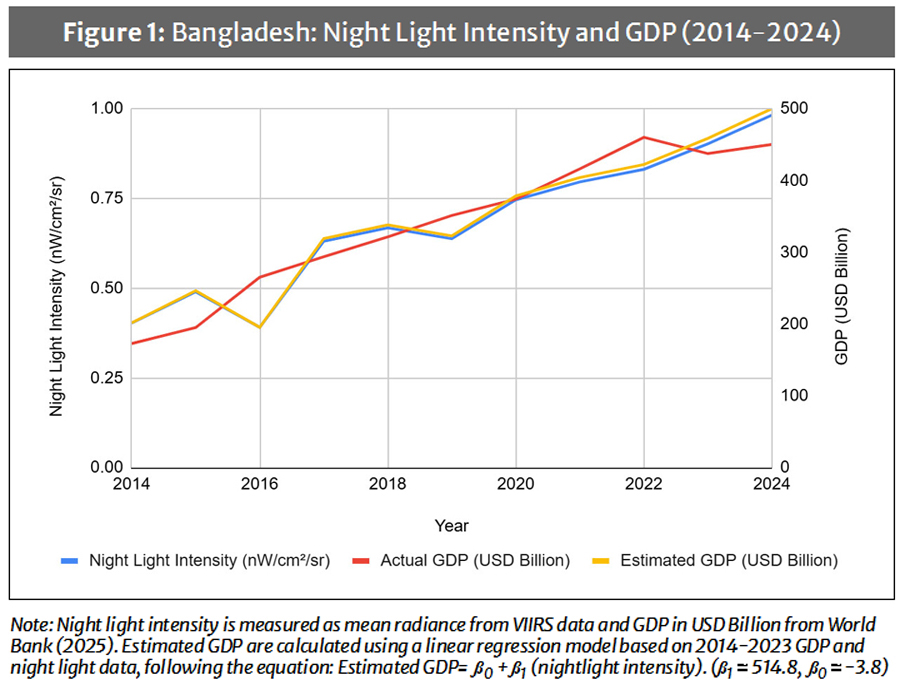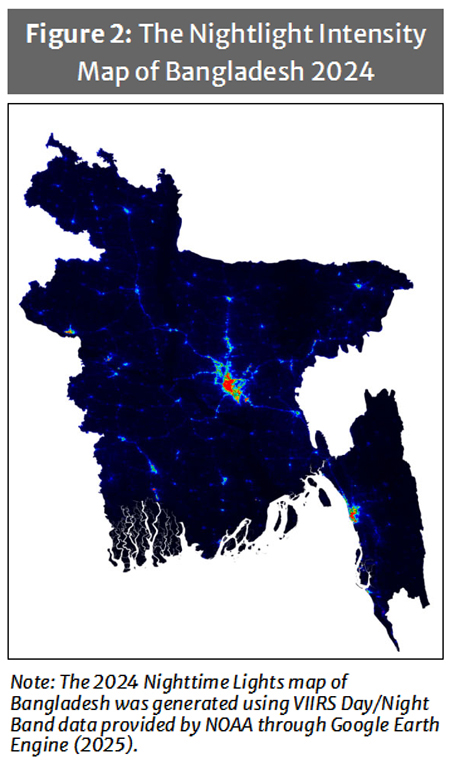
Published :
Updated :

The perception of night has been fundamentally changed ever since the invention of artificial light. The nighttime is not just darkness; it has an economy of its own. It is known as the "nighttime economy" (NTE), a simple term for all the economic activity that happens between 6:00 P.M. and 6:00 A.M. However, the problem with the nighttime economy is that it is not separate from the urban economy. It is diverse in nature and spread throughout various components of the urban economic system.
Satellite imagery of nighttime lights (NTL) is used to assess the development of the urban economy (Ghost et al., 2013). In Bangladesh, where there is a scarcity of official data on the informal sector, NTL data serves as an alternative for economic activities and energy consumption.

Satellite image of Bangladesh in 2024 at night, in Figure 2, is used as an example to demonstrate the process of analysing economic activity. There is a major difference in nighttime activity between urban and rural areas. It is a direct implication of lower consumption and production in rural areas compared to urban areas. But between the years 2014 and 2024, nightlight intensity rose almost in step with GDP, which can be observed in Figure 1. This tells us that there has been real economic progress in rural areas, despite its being lower than urban areas. Increased consumption and production imply higher income, better living conditions. As the economy grows, the cities become brighter. The glow of cities is a mirror of economic activity. However, is it enough to capture the full story?
Any discussion of the nighttime economy must begin with its two faces: the formal sector and the far more prominent informal one. Even though RMG appears to be the most visible formal sector at night, it is not the only one. There are several formal sectors like healthcare, emergency services, and public transportation, which also sustain the nighttime economy of Bangladesh. On the other hand, the informal sector is a crowded ecosystem that outshines the formal sector in both widespread presence and employment. According to the Bangladesh Labour Force Survey 2022, approximately 84.9 per cent of the total working population is informally employed (Dallakoti, 2024). This vast workforce consists of a broad range of workers, from vendors to tea stall owners to porters to rickshaw pullers. In most cases, these informal workers lack legal protection and formal recognition, yet they are crucial to the city's nighttime economy; they keep providing goods and services long after formal businesses have closed.
The nighttime economy presents opportunities for social, cultural, and economic enrichment. A booming nighttime ecosystem can contribute to a reduction in crime through the "eyes on the street" effect, where increased public presence discourages criminal acts. Cities throughout the globe realised this potential, with over 60 having appointed "night mayors" or dedicated departments similar to managing the nighttime economy. For instance, London's Night Czar has successfully pushed for 24-hour public transportation on weekends and night-only cultural events, animating new life into neighborhoods while ensuring safety and local businesses (London City Hall, n.d.). Bangladesh should explore similar strategies to advance a more comprehensive and prosperous urban environment.
However, utilising such opportunities requires addressing significant issues that are a direct threat to the sustainability and impartial growth of the nighttime economy of Bangladesh. Dhaka's fast, unplanned urbanization has exhausted its infrastructure, creating disparities that affect the nighttime economy. Traffic congestion, lack of safe public transport, and cities being hotter than surrounding rural areas make it quite challenging for informal workers. The growing threat of crime is another concern alongside the struggles of poor infrastructure and stifling heat. According to DMP statistics, at least 20 people were murdered during 145 mugging incidents in Dhaka in 2022 (The Business Standard, 2023). The prevalence of such crime has been a significant obstacle to the safe and inclusive growth of the nighttime economy. In Dhaka, teen gangs are majorly involved in nighttime drug trafficking and violence, frequently operating under the protection of local leaders ("Teen gangs in Bangladesh," 2025). An atmosphere of fear is created by unchecked gang presence, discouraging residents from working at night, which cannot be resolved by only increasing streetlights. A World Bank study exhibits a substantial gender gap in safety perception in low-income areas of Dhaka (Ahmed & Kotikula, 2021). As a result, it hinders women's opportunities to participate in the labour market and pursue economic activities at night beyond the household.
To realise the full potential of our nighttime economy, we must implement a comprehensive policy framework that addresses the challenges discussed. Investing in increasing streetlights and circulating robust CCTV surveillance could help deter crime. Extending the hours of public transportation, such as Dhaka Metro Rail, is imperative to ensure the safety of workers, especially women. Integrating the informal sector into the formal economy begins with recognising its significance and collecting data to incorporate in national statistics, enabling policymakers to design effective strategies. Addressing the imbalance revealed by satellite imagery, which is a high concentration of nightlight intensity in certain areas, e.g., Dhaka, could be vital in promoting a balanced economic development program.
The nighttime economy in Bangladesh is more than activity after dark; it is a part of the nation's urban economy. It exhibits both opportunities and issues of rapid urbanisation. On the one hand, the potential of recognising its vast informal workforce that can increase consumption, invite investment, and develop inclusive growth is implicated. On the other hand, hindrances continue to limit its full promise such as poor infrastructure, public safety concerns, and gender disparities. Streetlights and markets after dark reveal an economy that rarely sleeps, even when policy lags. Like Charles Dickens' reminder that "it was the best of times, it was the worst of times", Bangladesh's nights carry both hardship and possibilities. Whether they fade into shadow or shine with promise rests upon how the country chooses to shape its growth.
Md. Zarif Nazib Siddiquee and Zarin Islam Tarika are undergraduate students at the Department of Economics and Social Sciences, BRAC University. zarif.nazib.siddiquee@g.bracu.ac.bd, zarin.islam.tarika@g.bracu.ac.bd


 For all latest news, follow The Financial Express Google News channel.
For all latest news, follow The Financial Express Google News channel.